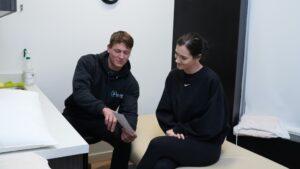If you’ve broken a bone in your life, you know that it is a painful and distressing experience. While the primary treatment for a broken bone is typically immobilization and medical intervention, physical therapy can play a crucial role in the recovery process.
In this post, we’ll explore the role of physical therapy in healing broken bones and provide some at-home remedies and exercises that can help alleviate pain and support your recovery journey.
Can Physio Help a Broken Bone?
When most people think of physiotherapy, they often associate it with muscle or joint injuries, not fractures. However, physiotherapy can be beneficial for individuals recovering from broken bones in several ways:
Range of Motion: After a broken bone has healed sufficiently, physiotherapists can help patients regain their range of motion. They’ll work on gently mobilizing the affected area, preventing stiffness and muscle atrophy.
Muscle Strengthening: Muscles surrounding the broken bone can weaken during immobilization. Physiotherapists prescribe exercises to rebuild strength and prevent muscle loss, enhancing overall stability and function.
Pain Management: A physical therapist employs various techniques to alleviate pain, including soft tissue mobilization, massage, and modalities like ultrasound or electrical stimulation. They can also educate patients on pain management strategies.
Balance and Coordination: After a bone heals, there may be a period of instability. Physical therapy can improve balance and coordination to reduce the risk of falls and further injuries.
Scar Tissue Management: Surgical treatments for broken bones often lead to scar tissue formation. Physiotherapists can help manage and reduce the impact of scar tissue on mobility.
Functional Recovery: Physical therapists focus on helping patients regain their ability to perform daily activities and return to their pre-injury functional level.
At-Home Remedies for Pain Relief
In addition to physiotherapy, there are several at-home remedies that can provide pain relief during the healing process of a broken bone:
Rest and Elevation: Rest is essential for healing. Elevating the affected area, such as propping up your broken limb on pillows, can help reduce swelling and discomfort.
Cold Compress: Applying a cold compress in the initial stages after either a compression fracture or bone fracture can help reduce pain and swelling. Make sure to wrap the ice pack in a cloth to avoid direct skin contact.
Over-the-Counter Pain Medications: Non-prescription pain relievers like acetaminophen or ibuprofen can help manage fracture pain and reduce inflammation. Follow the recommended dosage instructions.
Natural Anti-Inflammatories: Certain natural remedies, such as turmeric, ginger, and omega-3 fatty acids, have anti-inflammatory properties and may aid in reducing pain and inflammation.
Immobilization: Follow your healthcare provider’s recommendations for immobilizing the broken bone using casts, splints, or braces to prevent further injury and pain.
Diet and Nutrition: Consuming a balanced diet rich in calcium, vitamin D, and other essential nutrients can support bone healing. Consult with a healthcare professional or dietitian for guidance.
At-Home Exercises for Pain Relief
While it’s important to consult with your healthcare provider or physical therapist before attempting any exercises, there are several gentle movements and exercises you can incorporate into your recovery routine to alleviate pain and improve your overall comfort. For example:
Ankle Pumps (for lower limb injuries): While lying down, gently flex and point your toes, moving your ankle up and down. This can improve blood circulation and prevent blood clots.
Knee Flexion and Extension (for lower limb injuries such as an ankle fracture): While sitting, gently bend and straighten your knee. This exercise helps maintain knee mobility and reduces stiffness.
Elbow Flexion and Extension (for upper limb injuries): While sitting or lying down, bend and straighten your elbow. This exercise can prevent elbow stiffness and maintain range of motion.
Isometric Muscle Contractions: Contracting and relaxing the muscles around the injury without moving the joint can help strengthen the muscles without putting excessive stress on the bone.
Upper Body Range of Motion: Gently move your arms in various directions to maintain upper body mobility. Shoulder rolls, arm circles, and wrist movements can be beneficial.
Breathing Exercises: Deep breathing exercises help relax the body and can be particularly useful for pain management.
Core Strengthening: If your broken bone allows, you can perform gentle core-strengthening exercises like pelvic tilts and abdominal contractions.
It’s crucial to follow your healthcare provider’s recommendations and the guidance of your physiotherapist when incorporating these exercises into your routine. Start slowly and progress as you feel comfortable, and always stop if you experience pain beyond your tolerance.
Schedule a Physiotherapy Appointment for Your Broken Bone  Recovery
Recovery
It’s true! Physiotherapy can play a vital role in the healing process of a broken bone, helping you regain mobility, reduce pain, and enhance your overall quality of life during recovery.
Always consult with your healthcare provider to develop a personalized treatment plan that suits your specific injury and needs. With patience, time, and consistent effort, you can work towards a full recovery and return to your normal activities. Schedule an appointment with your physical therapist today to aid your recovery journey.








